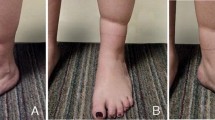Abstract
Objective
To evaluate the clinical and functional results of a technical procedure used in the surgical treatment of congenital constriction ring (CCR) in children.
Materials and methods
This was a retrospective study undertaken to evaluate the results of surgical techniques performed from January 1995 to December 2005 on 95 patients with 134 congenital constriction bands. Due to the drop-out of nine patients during follow-up, data on 86 patients (121 congenital constriction rings; average age at surgery 1 year 2 months) were analyzed. The extent of the constrictions was classified by according to the Patterson criteria. All patients were treated by two-stage sine plasty combined with removal of the fibrous groove and fasciotomy, with one-half of the ring removed during the first stage and the other half removed 1 week later during the second state. The surgical outcomes were assess according to the Moses criteria.
Results
Three types of CCR (Patterson criteria) were identified among the 86 patients (121 constriction rings): types I (5 patients, 4.1 %), II (107, 88.5 %), III (9, 7.4 %). Of the 121 constriction rings, good results were attained in 73.6 % and fair results in 26.4 %. Sensory deficits were seen in six patients immediately after the surgery but all six had improved to a normal condition at the final follow-up examination. There were no skin necrosis or wound healing problems.
Conclusion
The combined sine plasty/removal of fibrous groove and fasciotomy method reported here is a simple and safe surgical technique for treating CCR in children.






Similar content being viewed by others
References
Montgomery WF (1832) Observation on the spontaneous amputation of the limbs of the fetus in utero, with an attempt to explain the occasional cause of its production. Dublin Med Chem Sci J 1:140–144
Gorlin RJ, Cohen MM Jr, Hennekam RCM. Syndromes of the head and neck, 4th edn. Oxford University Press, New York, pp 10–13
Jones K (2005) Smith’s recognizable patterns of human malformation, 6th edn. WB Saunders, Philadelphia
Kiehn M, Leshem D, Zuker R (2007) Constriction rings: the missing link. Eplasty 8:4
Robin NH, Franklin J, Prucka S, Ryan AB, Grant JH (2005) Clefting, amniotic bands, and polydactyly: a distinct phenotype that supports an intrinsic mechanism for amniotic band sequence. Am J Med Genet A 137:298–301
Rayan GM (2002) Amniotic constriction band. J Hand Surg [Am] 27:1110–1111
Stevenson TW (1946) Release of circular constricting scars by Z flaps. Plast Reconstr Surg 1:39–42
Takayuki M (1984) Congenital constriction band syndrome. J Hand Surg 9A:82–88
Mehmet M, Mahmut S (2006) A new technique for correction of congenital constriction rings. Ann Plast Surg 57:646–652
Yohanness M, Williams HB (2008) Surgical correction of congenital constriction band syndrome in children: replacing Z-plasty with direct closure. Can J Plast Surg 16(4):221–223
Patterson T (1961) Congenital ring constrictions. Br J Plast Surg 69:532–569
Koichi T, Kazuo Y, Swanson AB (1984) Congenital constriction band syndrome. J Pediatr Orthop 4:726–730
Tada K, Yonenobu K, Swanson AB (1984) Congenital constriction band syndrome. J Pediatr Orthop 1984(4):726–730
Moses JM, Flatt AE, Cooper RR (1979) Annular constricting bands. J Bone Joint Surg 61-A(4):562–565
Patterson TJ (1961) Congenital ring constrictions. Br J Plast Surg 14:1–31
Kay SP, McCombe D (2005) Absence of fingers. In: Green DP, Hotchkiss RN, Pedersen WC, Wolfe SC (eds) Green’s operative hand surgery. Elsevier, Philadelphia, pp 1415–1430
Upton J (2006) Constriction ring syndrome. In: Mathes SJ, Hentz UR (eds) Plastic surgery. Elsevier, Philadelphia, pp 185–213
Upton J (1990) Congenital anomalies of the hand and forearm. In: McCarthy J, May JW, Little J (eds) Plastic surgery. WB Saunders, Philadelphia, pp 5373–5378
Hall EJ, Johnson-Giebink R, Vasconez LO (1982) Management of the ring constriction syndrome: a reappraisal. Plast Reconstr Surg 69:532–536
Streeter GL (1930) Focal deficiencies in fetal tissues and their relation to intra-uterine amputation. Contrib Embryol 22:1–44
Mutaf M, Sunay M (2006) A new technique for correction of congenital constriction rings. Ann Plast Surg 2006(57):646–652
Di Meo I, Mercer DH (1987) Single stage correction of constriction ring syndrome. Ann Plast Surg 19:469–474
Muguti GI (1990) The amniotic band syndrome-single stage correction. Br J Plast Surg 43:706–714
Beaty JH (1992) Congenital anomalies of lower extremity. In: Crenshaw AH (ed) Campbell’s operative orthopaedics, vol 3. Mosby, St. Louis, pp 2061–2158
Baker C Jr, Rudolf AJ (1971) Congenital ring constriction and intrauterine amputations. Am J Dis Child 121:393–400
Greg A, Errol G (1988) Congenial constriction band syndromes. J Pediatr Orthop 8:461–466
Sanmugasundaram TK (1999) Congenital anomalies. In: Kulkarni GS (ed) Textbook of orthopaedics and trauma, vol 4. Jaypee Brothers Medical Publishers, Chennai, pp 3439–3947
Tachdian MO (2002) Paediatrics orthopaedics, vol 1, 3rd edn. W.B Saunders, Philadelphia, pp 461–466
Upton J, Tan C (1991) Correction of constriction rings. J Hand Surg 16A:947–953
Greene WB, Hill C (1993) One stage release of congenital circumferential constriction bands. J Bone Joint Surg Am 75:650–655
Visuthikosol V, Hompuem T (1988) Constriction band syndrome. Ann Plast Surg 21:489–495
Daniel RK, Williams HB (1973) The free transfer of skin flaps by microvascular anastornoses. An experimental study and a reappraisal. Plast Reconstr Surg 52:16–31
Wanter BG (1993) One-stage release of congenital circumferential constriction bands. J Bone Joint Surg 75(5):650–655
Quintero RA, Morales WJ, Phillips J, Kalter CS, Angel JL (1997) In utero lysis of amniotic bands. Ultrasound Obstet Gynecol 10:316–320
Sentilhes L, Verspyck E, Eurin D, Ickowicz V, Patrier S, Lechevallier J, Marpeau L (2004) Favourable outcome of a tight constriction band secondary to amniotic band syndrome. Prenat Diagn 24:198–201
Author information
Authors and Affiliations
Corresponding author
About this article
Cite this article
Hung, N.N. Congenital constriction ring in children: sine plasty combined with removal of fibrous groove and fasciotomy. J Child Orthop 6, 189–197 (2012). https://doi.org/10.1007/s11832-012-0420-4
Received:
Accepted:
Published:
Issue Date:
DOI: https://doi.org/10.1007/s11832-012-0420-4




